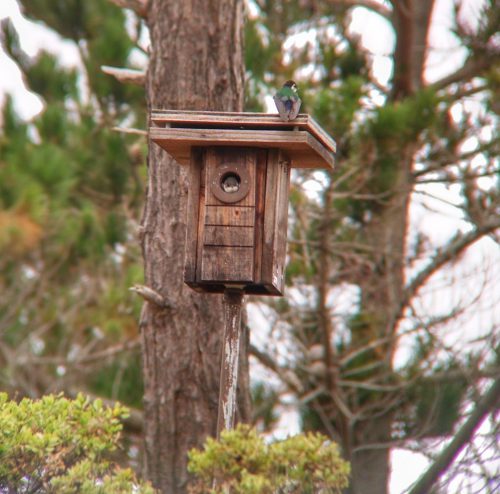Home Tweet Home 2016
upload and share photos
Photo Submission
Submitted By
Amanda Preece
Pacific Grove, CA, United States
Description
This is the first time I’ve heard of this happening. A flighted juvenile VGSW from some other nest (not one of the nest boxes that were being monitored, none of them had fledged at this time) decided to take up residence inside this nest box which already housed 4 other VGSW chicks. The small chicks were about 14 days old at this point. He would beg from these parents (not his own) on the wing as they foraged and then race them back to the nest box and get inside just in time to turn around and stick his head out of the entrance hole and open his mouth for the bugs. I admit that I chased him off whenever I noticed him hanging out in the nest box. I was concerned he would stop the flow of food to the smaller chicks in the nest box. While I was impressed with his cunning, his deviousness was hurting the offspring of these hard-working parents, so he had to go! He hung around for about 2 days then he must have decided to put forth some effort and feed himself.
Category
Species
Tags
Continue Browsing
Tag:
Conspecific Nest Parasitism
2 responses to “Conspecific Nest Parasitism”
Leave a Reply
Explore
Nearby Submissions
Recently Liked
- No Results Yet.






A very interesting case of kleptoparasitism (parasitism by stealing food) in swallows! How clever. I have never heard of this species engaging in this behavior.
Yes, my name is Gerald Rudy, living in Central Pa. near Harrisburg. We have lots of blue birds around here. I haven’t actually seen the helper activity from the juvenile bluebirds, but they do seem to hang around for a while after the adults have had their later broods of nestlings. I built several nest boxes over the years and at least one of the older boxes seems to be a favorite of one pair of blue birds that comes back year after year. They are very friendly, I call them “Mickey” and “Molly”, they can be very entertaining too. The birds seem to know their names as they frequently come when I call, especially when they see me with my bag of dried meal worms. We often sit and converse for long periods of time. I’ve had as many as three broods of bluebirds in the same box during a summer. I’ve often noticed that the smaller birds, sparrows, house finches and purple finches tend to gang up on and harrass and bully the larger blue birds, especially as the blue birds try to establish ownership of the nesting box.